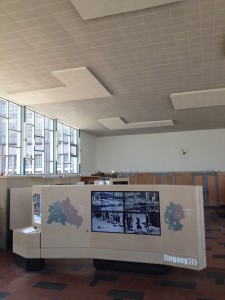
Remnants of the Berlin Wall remain throughout the city, either as crumbling reminders of this bizarre and tragic division of a people and place, or as formal memorials, or in cobbles you can simply step over without being otherwise aware of any change in the street. But if the concrete wall was the impermeable barrier that daily taunted East Berliners, one to be scorned, resented, but ultimately accepted as part of day-to-day life, it was at its few and tightly controlled crossing points where the human drama was at its most poignant, the pain most raw. It was here partings occurred, and where faceless authority took on a human dimension, perhaps making it all the harder to bear.
Prior to the building of the Wall in 1961, 2.8 million people had left the Eastern GDR for the West, several thousands right up until it went up, literally overnight. Berlin had been the key point for comparatively risk-free defections – while the national border between East and West Germany was already fortified, in Berlin you could just about cross undetected by simply taking an underground train. Once the Wall was up, however, it become almost impossible to escape the East. For the fortunate ones who managed it, temporarily or even permanently, Friedrichstraße station became the primary legitimate gateway. The Tränenpalast – the ‘Palace of Tears’, as it became known – was a sort of annexe to the station, opened the following year by the East Germans and presented to their citizens as a place of hospitality to process movement between countries. It was, of course, nothing of the sort.
For those leaving, and those left behind, this surprisingly light and airy glass structure was the setting for painful partings, of loved ones, of lives, for who knows how long. It’s now a museum, full of exhibits which tell of many of the experiences of the protagonists in this three-decades-long tragic drama. It describes the experience of being processed (‘it was humiliating, the tone was cutting’ recalls one who crossed the border), of how the state used it as just one more way of reinforcing its fearsome control over its citizens. We learn of how love remarkably formed across the border, but also how the Wall kept apart lovers who awoke one August morning to find themselves on opposite sides of a deadly divide, one which created, as an East Berliner puts it, ‘a nation of prisoners’.
There are tales of youth visits from West to East (though not in reverse), of escape attempts, of how ‘Intershops’ – East German duty-free shops which traded in Western goods, selling them to travellers from either direction – made East Berlin billions. We learn of one East Berlin family who happened to be visiting the West when the Wall went up and thought it better to stay (keeping their unused return ticket as a memento); and, 28 years later, how another persevered for months to finally get permission to leave (which involved the confiscation of their property) – and were so jubilant at having done so they failed to notice when the Wall fell only hours later.
The story of the Wall’s fall and Germany’s reunification is also explored, with the views and concerns of the key political protagonists – Kohl, Thatcher, Mitterand and others – as well as citizens of Berlin East and West captured in video, images and words. It’s a fitting coda to the building’s history, and a moving glimpse of the emotions generated by the astonishingly rapid events when, after nearly three decades, tears of sorrow suddenly gave way to ones of a very different sort.
The Tränenpalast, Berlin – admission free